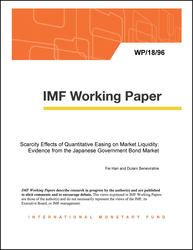
Scarcity Effects of Quantitative Easing on Market Liquidity: Evidence from the Japanese Government Bond Market
Quantitative easing could improve market liquidity through many channels such as relaxing bank funding constraints, increasing risk appetite, and facilitating trades. However, it can also reduce market liquidity when the increase in the central bank’s holdings of certain securities leads to a scarcity of those securities and hence higher search costs in the market. Using security-level data from the Japanese government bond (JGB) market, this paper finds evidence of the scarcity (flow) effects of the Bank of Japan (BOJ)’s JGB purchases on market liquidity. Moreover, we also find evidence that such scarcity effects could dominate other effects when the share of the BOJ’s holdings exceeds certain thresholds, suggesting that the flow effects may also depend on the stock.
Publication date: May 2018
ISBN: 9781484353677
$18.00
Add to Cart by clicking price of the language and format you'd like to purchase
Available Languages and Formats
| English |
Prices in red indicate formats that are not yet available but are forthcoming.
Topics covered in this book
This title contains information about the following subjects.
Click on a subject if you would like to see other titles with the same subjects.
Quantitative easing , quantitative and qualitative monetary easing , market liquidity , Japanese government bond , scarcity effects , Models with Panel Data , Single Equation Models: Single Variables: Instrumental Variables (IV) Estimation , Quantitative Policy
Summary
Copyright © 2010 - 2024
Powered by:
AIDC



